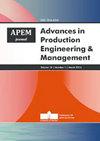A deep learning-based worker assistance system for error prevention: Case study in a real-world manual assembly
IF 2.5
3区 工程技术
Q2 ENGINEERING, MANUFACTURING
引用次数: 10
Abstract
Modern assembly systems adapt to the requirements of customised and short-lived products. As assembly tasks become increasingly complex and change rapidly, the cognitive load on employees increases. This leads to the use of assistance systems for manual assembly to detect and avoid human errors and thus ensure consistent product quality. Most of these systems promise to improve the production environment but have hardly been studied quantitatively so far. Recent advances in deep learning-based computer vision have also not yet been fully exploited. This study aims to provide architectural, and implementational details of a state-of-the-art assembly assistance system based on an object detection model. The proposed architecture is intended to be representative of modern assistance systems. The error prevention potential is determined in a case study in which test subjects manually assemble a complex explosion-proof tubular lamp. The results show 51 % fewer assembly errors compared to a control group without assistance. Three of the four considered types of error classes have been reduced by at least 42 %. In particular, errors by omission are most likely to be prevented by the system. The reduction in the error rate is observed over the entire period of 30 consecutive product assemblies, comparing assisted and unassisted assembly. Furthermore, the recorded assembly data are found to be valuable regarding traceability and production improvement processes.基于深度学习的工人辅助系统的错误预防:在现实世界的人工组装案例研究
现代装配系统适应定制和短寿命产品的要求。随着装配任务的日益复杂和快速变化,员工的认知负荷也随之增加。这导致使用辅助系统进行手动组装,以检测和避免人为错误,从而确保一致的产品质量。大多数这些系统承诺改善生产环境,但迄今为止几乎没有进行定量研究。基于深度学习的计算机视觉的最新进展也尚未得到充分利用。本研究旨在提供基于目标检测模型的最先进装配辅助系统的架构和实现细节。拟议的架构旨在成为现代援助系统的代表。在一个案例研究中,测试对象手动组装一个复杂的防爆管状灯,确定了错误预防潜力。结果显示,与没有帮助的对照组相比,装配错误减少了51%。在四种考虑的错误类别中,有三种至少减少了42%。特别是,由于遗漏而导致的错误最有可能被系统所预防。错误率的降低是在30个连续产品装配的整个期间观察到的,比较辅助和非辅助装配。此外,记录的装配数据对于可追溯性和生产改进过程是有价值的。
本文章由计算机程序翻译,如有差异,请以英文原文为准。
求助全文
约1分钟内获得全文
求助全文
来源期刊

Advances in Production Engineering & Management
ENGINEERING, MANUFACTURINGMATERIALS SCIENC-MATERIALS SCIENCE, MULTIDISCIPLINARY
CiteScore
5.90
自引率
22.20%
发文量
19
期刊介绍:
Advances in Production Engineering & Management (APEM journal) is an interdisciplinary international academic journal published quarterly. The main goal of the APEM journal is to present original, high quality, theoretical and application-oriented research developments in all areas of production engineering and production management to a broad audience of academics and practitioners. In order to bridge the gap between theory and practice, applications based on advanced theory and case studies are particularly welcome. For theoretical papers, their originality and research contributions are the main factors in the evaluation process. General approaches, formalisms, algorithms or techniques should be illustrated with significant applications that demonstrate their applicability to real-world problems. Please note the APEM journal is not intended especially for studying problems in the finance, economics, business, and bank sectors even though the methodology in the paper is quality/project management oriented. Therefore, the papers should include a substantial level of engineering issues in the field of manufacturing engineering.
 求助内容:
求助内容: 应助结果提醒方式:
应助结果提醒方式:


